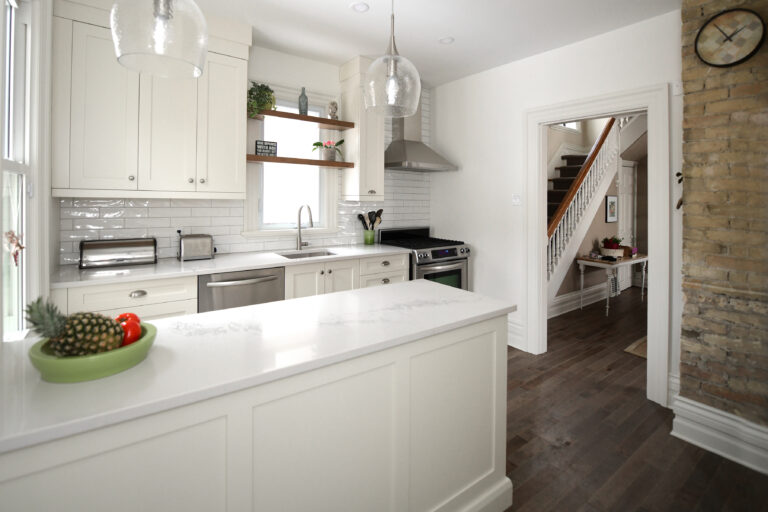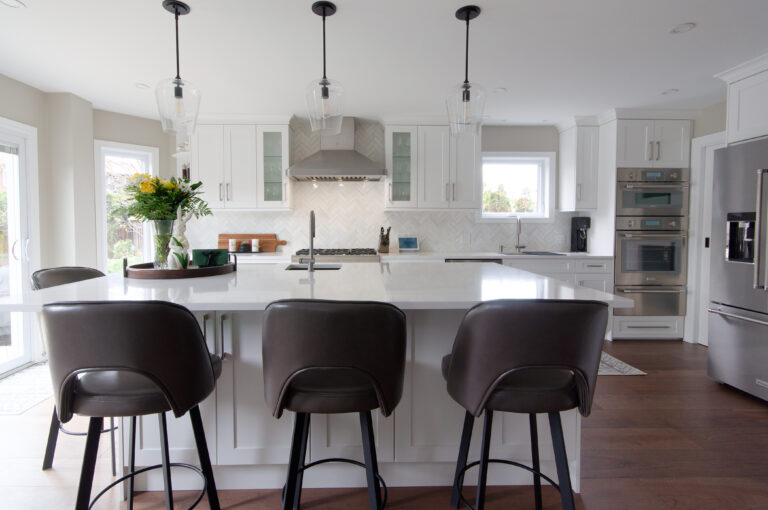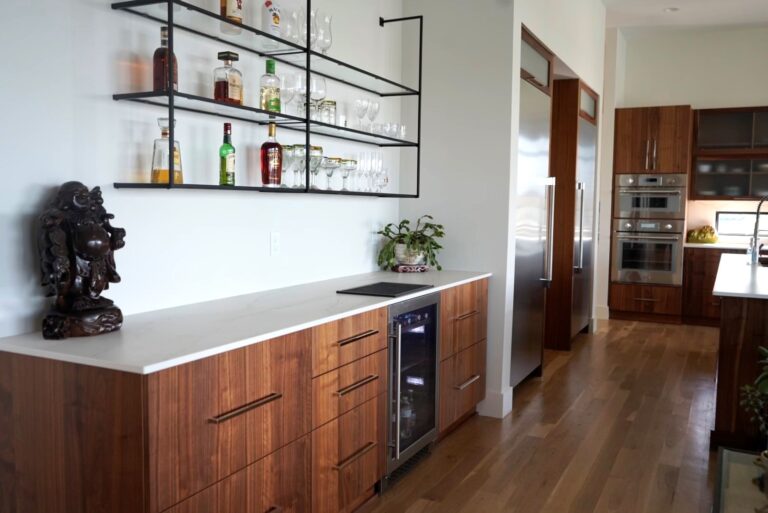Are you ever scrolling through Pinterest, dreaming of that perfect kitchen style, but are unsure of where to start? We have the ultimate guide to help you find your design style and even whipped up a fun quiz to uncover your perfect kitchen!
A TRADITIONAL KITCHEN
A traditional kitchen is homey and cozy, just like a country kitchen, but much more formal. If you’re looking for a cookie-cutter design, then a traditional kitchen isn’t for you, they’re quite the opposite. You have the freedom to experiment with design elements that resonate with your unique tastes.
One thing that sets the traditional kitchen apart from all other designs isn’t the embellishments themselves, but the amount of ornamentation used in the design. They’re incorporated everywhere, the mouldings, the doors, the decorative range hoods, and so on.
In this short article, we’ll talk about what defines the style and look at the elements that make up the beauty of the design. If you want to know more about traditional kitchen design, then keep reading.

The Timeless Appeal of Traditional Kitchens
Traditional kitchen design is timeless. They’ve been around for so long, yet they’re still one of the top desirable designs. A traditional kitchen is far from an outdated kitchen. And even though trends come and go, the traditional kitchen and furniture style has remained popular.
What’s considered to be “modern” today won’t be considered modern a few years from now. The modern style has its own perks, but a traditional kitchen does its own great job of incorporating special stylized touches making the appeal of the traditional kitchen timeless.
No matter what fashion fads Instagram influencers appear to present or whatever happens to be everyone’s home makeover wish list, the traditional decorative accents are still going strong.
All that, despite the fact that a traditional kitchen is on the opposite side of the design spectrum as modern kitchens.
Where a modern kitchen has sleek, clean lines and is streamlined and minimalistic, the traditional kitchen is anything but that.
Instead, the focal point in a traditional kitchen focuses on ornamentation and embellishments, along with great decorative finishes. The upper cabinets of such a classic kitchen usually have more of them than the base cabinets. These little details are what’s so admired about the traditional look.
Now let’s go into the little details and see what beauty hides behind each element of a traditional space.

Neutral Backdrop Colours in Traditional Kitchens
A Traditional kitchen uses a neutral colour scheme as a backdrop to make the details in the ornamentation stand out. Some of these neutral colours include cream, taupe, and dark brown paints and stains.
Synthetic finishes like lacquers, veneers, and laminate don’t quite fit into this classic kitchen. They fit better in modern and contemporary kitchens. For traditional kitchen cabinets, the more natural the finish the better.
Also, a traditional kitchen goes above and beyond to create a cozy mood and comfortable atmosphere with warm colour tones. It gives the traditional design a feeling of laid-back elegance.
The only use for a non-neutral colour in a traditional kitchen is most likely more of a pale, muted shade. It could also be a colour found in nature like a sage or olive green that’s glazed to look more aged and antique.
Next, let’s get into the cabinetry and the things that go with it.
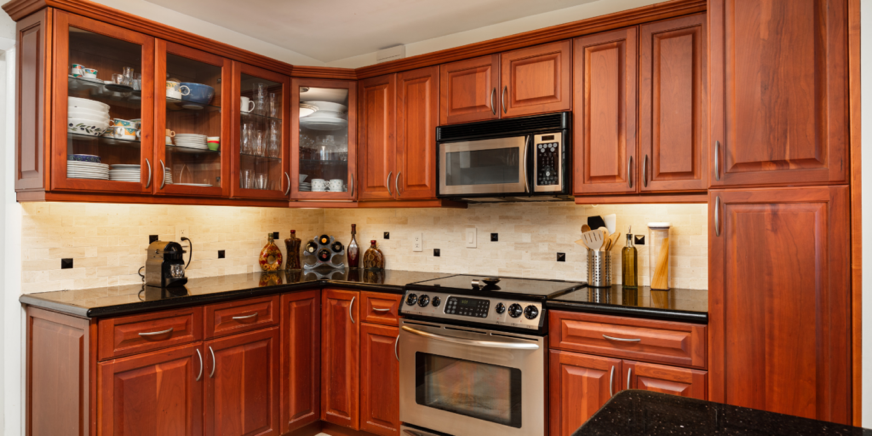
Cabinetry in Traditional Kitchens
Traditional kitchens are all about details in every area of the space. The easiest way to distinguish a traditional kitchen from other designs are the amount of details used and the neutral colours.
However, there are a few other indicators that will tell you whether you’re standing in a traditional kitchen or not…that’s the cabinet door style. Let’s get right into it.

Door Styles in Traditional Kitchens
Your cabinet door style is one of the most important factors in your kitchen design. They’re not only the most visible feature, but they can also be the most expensive.
The traditional door style emits a strong feeling of class and elegance. They’re typically recessed and raised panel doors that give great character to the doors.
Next, we’ll look at the glass front cabinet door element.
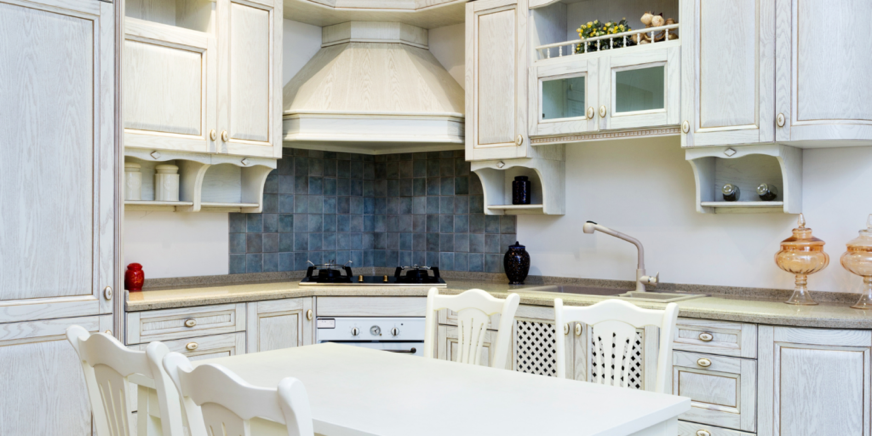
Glass Front Cabinet Doors
These deserve special mention because almost every traditional kitchen has them.
They often have some cabinet doors that have a glass front which is another way they elevate the delicacy and charm.
Glass-front cabinets are versatile, so most inserts will work with your traditional kitchen design.
They’re not only versatile in terms of insert choices, but also in which style they go well with. They’re just as much at home in a transitional and farmhouse kitchen as they are in a traditional one.
You can add to the glass and play with the architectural mullions to add elegance to the space. Other options include frosted or textured glass. The level of detail is key to every traditional kitchen.
Next, let’s talk about decorative range hoods…
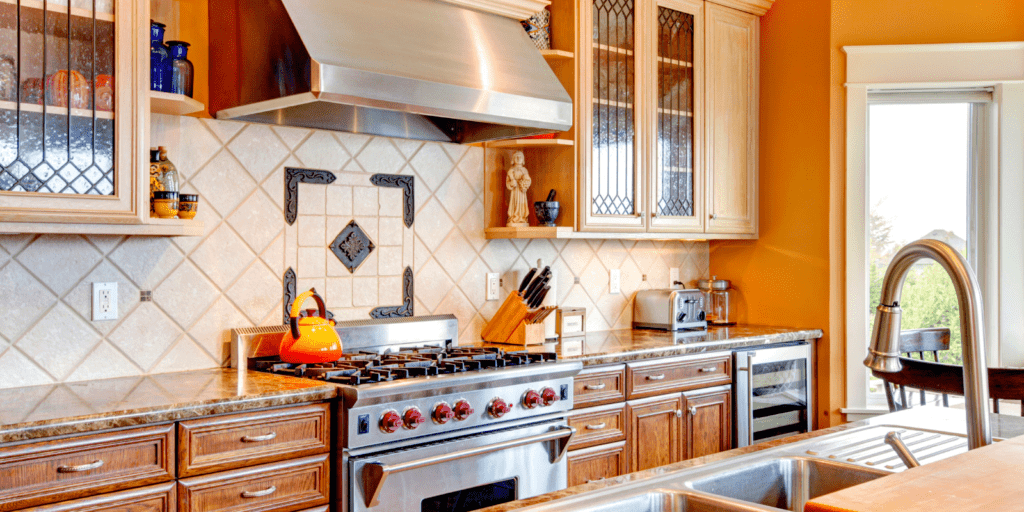
The Decorative Range Hood in a Traditional Kitchen
A large, decorative range hood is a staple item in traditional kitchens that represent the style perfectly. They’re custom hoods that are not afraid to show off their ornaments and be as flashy as possible. They stand out and are there to draw in all eyes. It’s there to impress, not just to work.
Now, let’s cover which countertops would be best in traditional kitchens.
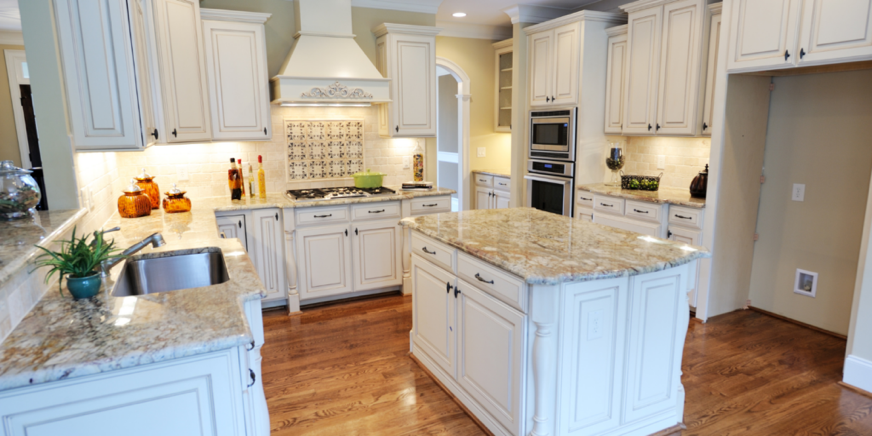
Countertops in a Traditional Kitchen
The more natural the better it fits into the traditional kitchen. So natural materials like granite countertops or butcher block countertops are the most common.
Sometimes engineered quartz is used, but it’s usually a natural-looking slab to mimic marble countertops.
If you want to have your space designed in the traditional style with some rustic in it, you might want to pick out a countertop even closer to nature.
The live edge countertop is a slab of wood sliced right off the tree. Feel free to read more about them on our live edge countertop blog post.
Now, let’s go over which flooring is great for traditional kitchens.
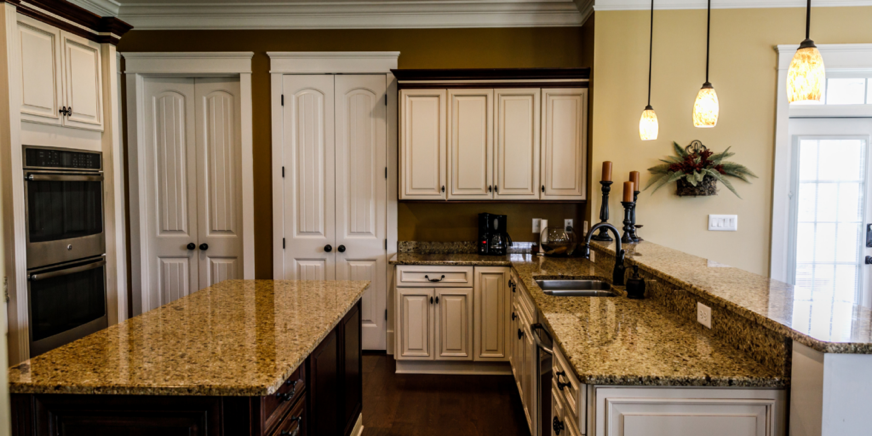
Flooring in a Traditional Kitchen
When it comes to flooring in traditional kitchens, all you need to think about is whether it fits in with the old-school and ever-classy theme. So hardwood, stone or tile all fit in perfectly.
Vinyl and laminate can mimic these natural materials but will never be the same. So only choose these if you’re budget is tight.
Next, let’s talk about the typical layout of traditional kitchens…
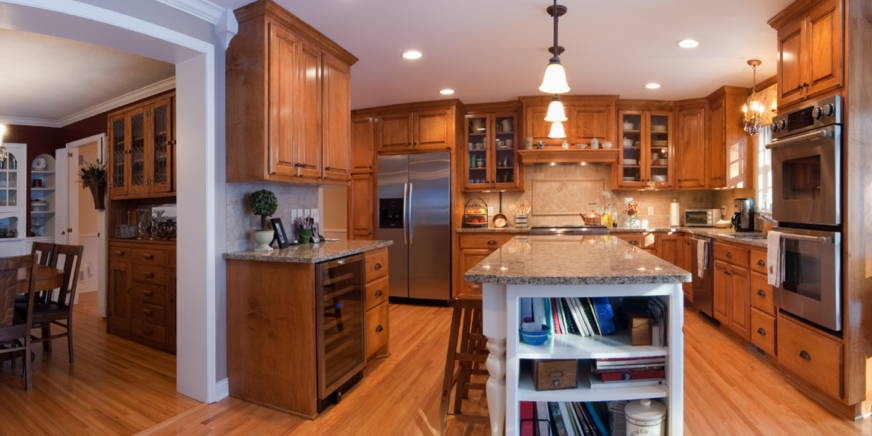
Traditional Kitchen Layouts
Most traditional style kitchens are often big spaces with large windows. If you look at images of traditional kitchens for inspiration, you’ll notice most have a kitchen island with at least two perimeter cabinets.
Feel free to check out some inspirational photos in Houzz’s collection to get your ideas going.
Square footage is quite important, no matter what you hear people say. Here’s why: think of a five-star hotel lobby. You’ll see luxurious and lavish additions like chandeliers and huge floral bouquets. They’re much easier to appreciate and adore in a spacious area.
Imagine all that squished into a tiny home, it would be overcrowded with no room to walk.
This doesn’t mean you can’t have a traditional kitchen designed to fit into a smaller kitchen space. But it does mean you’ll need to be more selective with how many adornments you include in the design.
The less space the more the saying “sometimes, less is more” comes to mind.
Now, let’s go over the backsplash in traditional kitchens.

Backsplash in a Traditional Kitchen Style
When it comes to the backsplash in a traditional kitchen, the simpler, the better.
The fancier the backsplash the more you take away from the cabinets, which are your show pieces in a traditional-style kitchen.
Go for neutral tiles and subtle patterns, this way you’ll avoid overshadowing or competing with the detail in the cabinets.
Lastly, let’s cover the hardware used in the traditional-style kitchen.

Traditional Style Kitchen Cabinet Hardware
The hardware in a traditional kitchen gives you another great opportunity to show off your taste in detail. They’re usually vintage looking and finished in gold, oil-rubbed bronze, or brushed nickel.
Final Thoughts
The traditional kitchen is one of the most popular design styles when it comes to creating a room full of little details. A traditional kitchen is still a top design choice for many families. It brings out a classy and luxurious feel and yet is cozy at the same time.
A traditional kitchen typically incorporates painted cabinets, often with glass front doors, granite or butcher block countertops, and hardwood floors. A traditional kitchen uses as many classic elements as it can fit in without looking stuffed.
There is no one standard way to design a traditional kitchen. However, it’s important to integrate your personality and unique style into its design. Be sure, though, that it’ll feature plenty of natural materials, a social space to gather and accessories to make it feel warm and cozy to be in.




